NutmegGraters.Com

Investigation Profile # 6. :
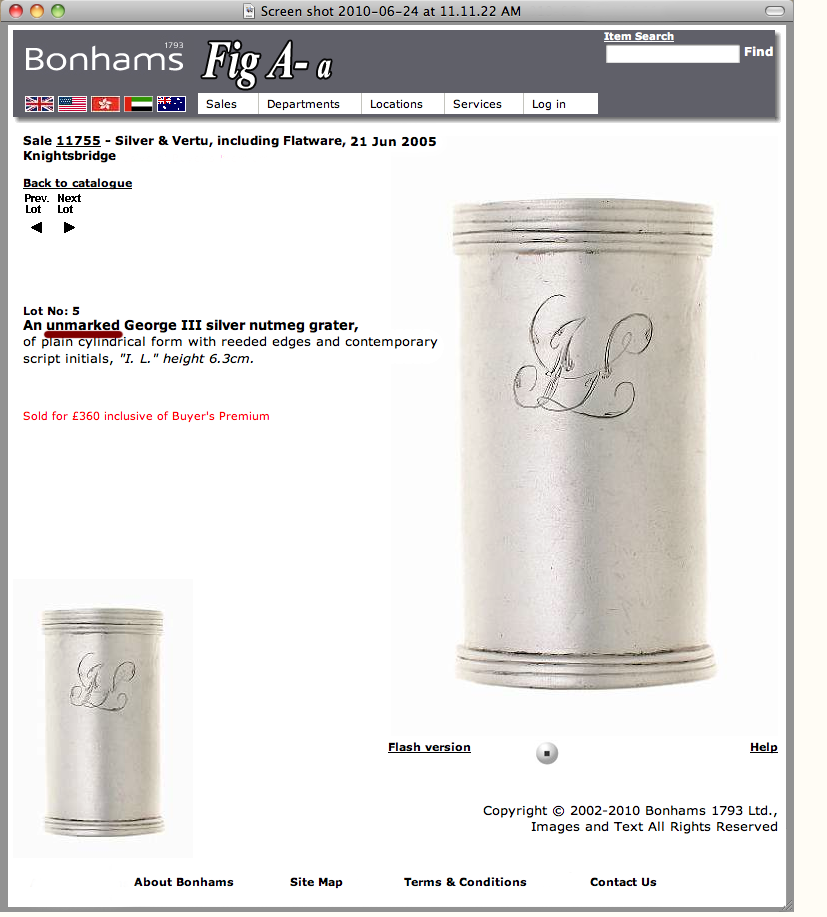 To our great dismay on June 24th, 2010, we discovered our first nutmeg grater bearing a problematic American maker's mark spuriously attributed as "S .Kirk" "10•15". This problem was discovered during our on-line search while viewing post-auction results from an internationally known auction company. The auction house had published their June 21, 2005 "Sale 11755" describing "Lot No: 5 – An unmarked George III silver nutmeg grater, of plain cylindrical form with reeded edges and contemporary script initials, 'I. L.: height 6.3cm." which sold for "£360.00." We purchased this same silver nutmeg grater (Fig A-b) on September 15, 2006, now bearing the prominent mark
To our great dismay on June 24th, 2010, we discovered our first nutmeg grater bearing a problematic American maker's mark spuriously attributed as "S .Kirk" "10•15". This problem was discovered during our on-line search while viewing post-auction results from an internationally known auction company. The auction house had published their June 21, 2005 "Sale 11755" describing "Lot No: 5 – An unmarked George III silver nutmeg grater, of plain cylindrical form with reeded edges and contemporary script initials, 'I. L.: height 6.3cm." which sold for "£360.00." We purchased this same silver nutmeg grater (Fig A-b) on September 15, 2006, now bearing the prominent mark
"S .KIRK" "10•15" (Fig A2). Presently, NutmegGraters.Com is aware of five examples with these identical and problematic maker's marks (four of these are presented here, within Profile #6).
Investigation Profile #6 examines four silver nutmeg graters, each bearing identical but spurious "S .KIRK" "10•15" maker's marks. As demonstrated within this profile, these marks differ from confirmed examples of the genuine maker's marks by this silversmith. 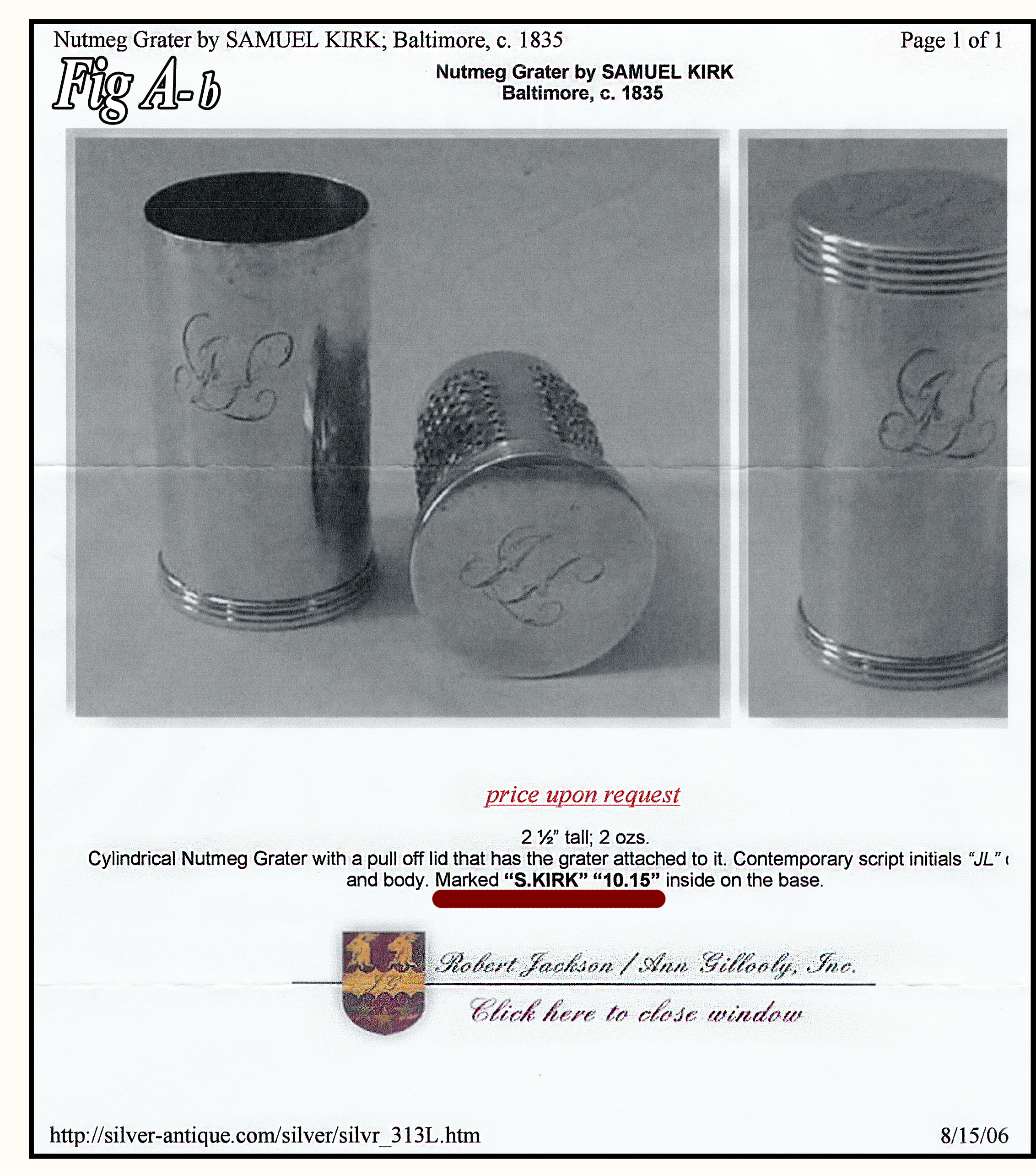
[NOTE: The original KIRK name stamps (or touchmark stamps) used to form the KIRK maker marks were donated by the Kirk-Stieff company to the Maryland historical society which aided this investigation.]
Form and Style:
Compiled for more than 30 years, the Klopfer Image File represents the documentation, study and image collection of more than 3000 silver nutmeg graters: [sources include but are not limited to ~ books and auction catalogs, on-line sales or auction archival resources, private and public collections.] This private file details nutmeg grater form, decorative styles, and marks. This data collection is useful when making comparative assessments, and indicate that the four nutmeg graters in question are in forms and styles created between Circa 1780 to 1850; that the (Fig A~ series) and (Fig C ~ series) examples are typical to known French types; (Fig B ~ series) is a product known from Birmingham or London; and (Fig D ~ series) is a style that was produced widely and over a lengthy duration.
Four Nutmeg Graters Bearing Spurious Maker's Marks "S .Kirk":
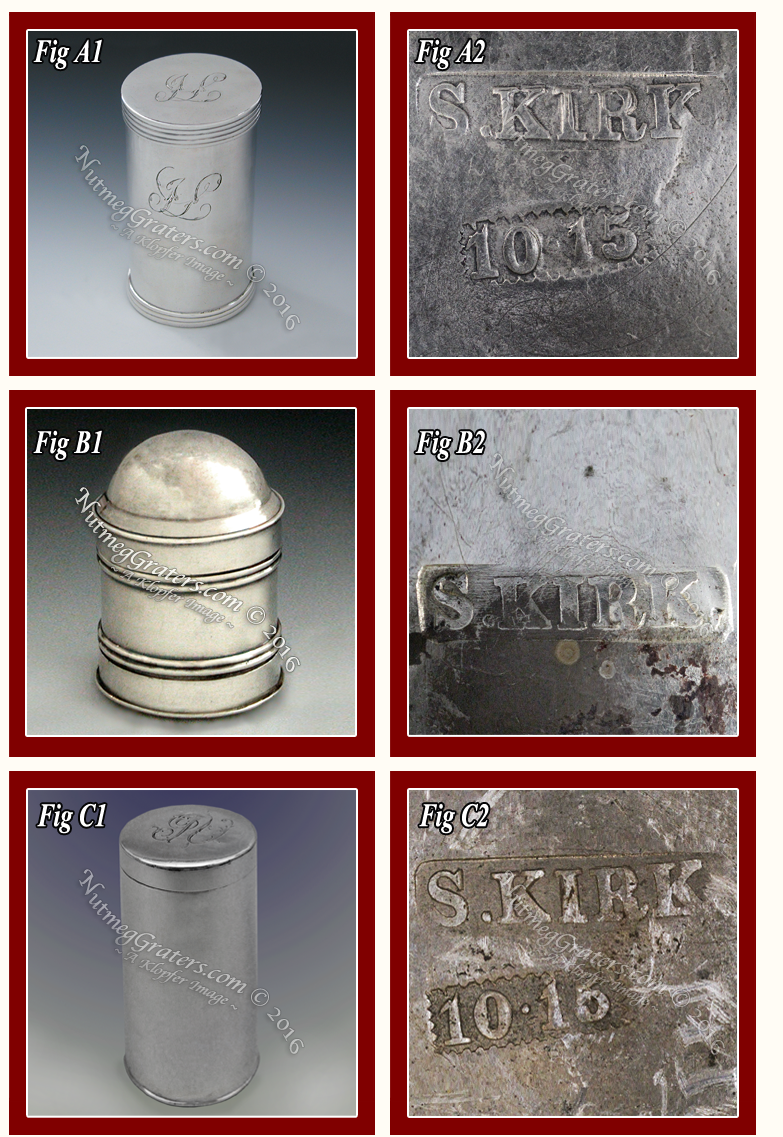
Purchase and Background Information:
(Figs A1& A2 [and A~series]) On June 21, 2005, this silver nutmeg grater was marketed by an internationally recognized auction company, located in Knightsbridge, England; it was described as "Lot No: 5 ~ An unmarked George III silver nutmeg grater, of plain cylindrical form with reeded edges and contemporary script initials, 'I. L.' height 6.3cm." (Fig A-a). Concurrently, LiveAUCTIONEERS featured this sale, reprinting these exact descriptions and photos for this nutmeg grater. In 2006, Ann Gillooly, of Robert Jackson / Ann Gillooly, Inc. 4897 Landisville Road, Doylestown, Pennsylvania, 18901 offered this same item for sale to us through correspondence, describing "We have recently acquired an American Silver Nutmeg Grater by Samuel Kirk, Baltimore, MD., c 1835." Also enclosed was a Jackson-Gillooly web-site advertisement (Fig. A-b) which described "Nutmeg Grater by SAMUEL KIRK, cylindrical Nutmeg Grater with a pull off lid that has the grater attached to it. Contemporary script initials "JL" on cover and body. marked 'S.KIRK' '10.15' inside on the base." A written guarantee of authenticity was provided by the seller, which to date has not been honored.
(Fig B1 [and B ~ series]) This dome covered cylinder nutmeg grater with double lids, was sold on October 6, 2006 as E-Bay Item # 160042550841 by Robert Lloyd, Inc, Gallery 63 Manhattan Antique center, 40 W. 25th Street., N.Y.C., NY 10022. The Lloyd ad described "Up for sale is a very rare early American Southern coin silver Nutmeg Grater made in Baltimore, Md. circa 1830 by Samuel. Kirk. This charming little rarity measures just 1 in. high. The pull off covers reveal the grater compartment to store the nutmeg. It is marked inside the flat cover "S.KIRK". There is some staining inside both covers that we have not attempted to clean off. Early American nutmeg graters are very scarce and seldom seen prior to 1870. There is no monogram or engraving and no sign of any removal. The entire surface has a great mellow patina and has not been over polished. We will sell this great rarity with no reserve." "ALL ITEMS WILL BE AVAILABLE FOR INSPECTION AT OUR GALLERY. 1050 SECOND AVENUE, NEW YORK, N.Y. GALLERY #63. 212-750-8752". Noteworthy, the companion "10•15" mark that accompanies the "S.KIRK" maker's mark was absent.
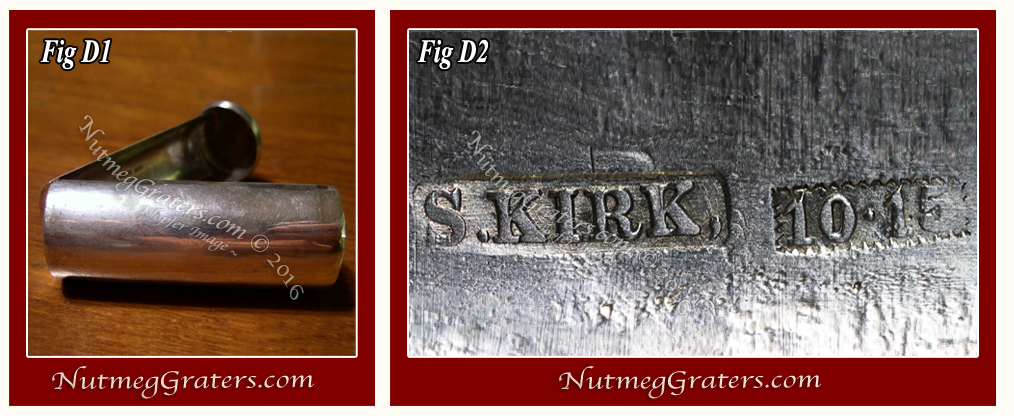
(Fig C1 & C2 [and C ~ series]) This cylindrical silver nutmeg grater was offered for sale in November 2010 by Ann Gillooly, of Robert Jackson | Ann Gillooly, Inc. 4897 Landisville Road, Doylestown, Pennsylvania, 18901. It was described as: "Nutmeg Grater by SAMUEL KIRK, BALTIMORE, C. 1835. Cylindrical Nutmeg Grater with a hinged lid and a pull out grater. Marked inside on the base 'S.KIRK' '10•15'. Contemporary script monogram on the lid 'PV'. 1 ⁷⁄₈" high." The provenance was not available. In November 2010, NutmegGraters.Com photographed this item after which concerns regarding the mark were discussed with the seller. In August, 2011, the nutmeg grater was posted for sale on Cyberattic.Com by Hampton Galleries, 7 Times Square, 39th Floor, New York, New York 10026-6569 (item 7247); this ad included 6 quality images of the piece which was described as "RARE NUTMEG GRATER, Samuel Kirk, Baltimore (c. 1830-35)" "Very rare American nutmeg grater by Samuel Kirk, Baltimore Maryland (c. 1830-35) 1 ¹⁵⁄₁₆" tall, 1" wide cylindrical body seamed on side, hinged cover with large feather script monogram 'GV' on top, few dings around body, original metal grater, marked inside on bottom "S.KIRK" and "10.15", each in rectangular punch." [NOTE: Although image are not shown here, NutmegGraters.Com retains copy of all on-line ad images and text.]
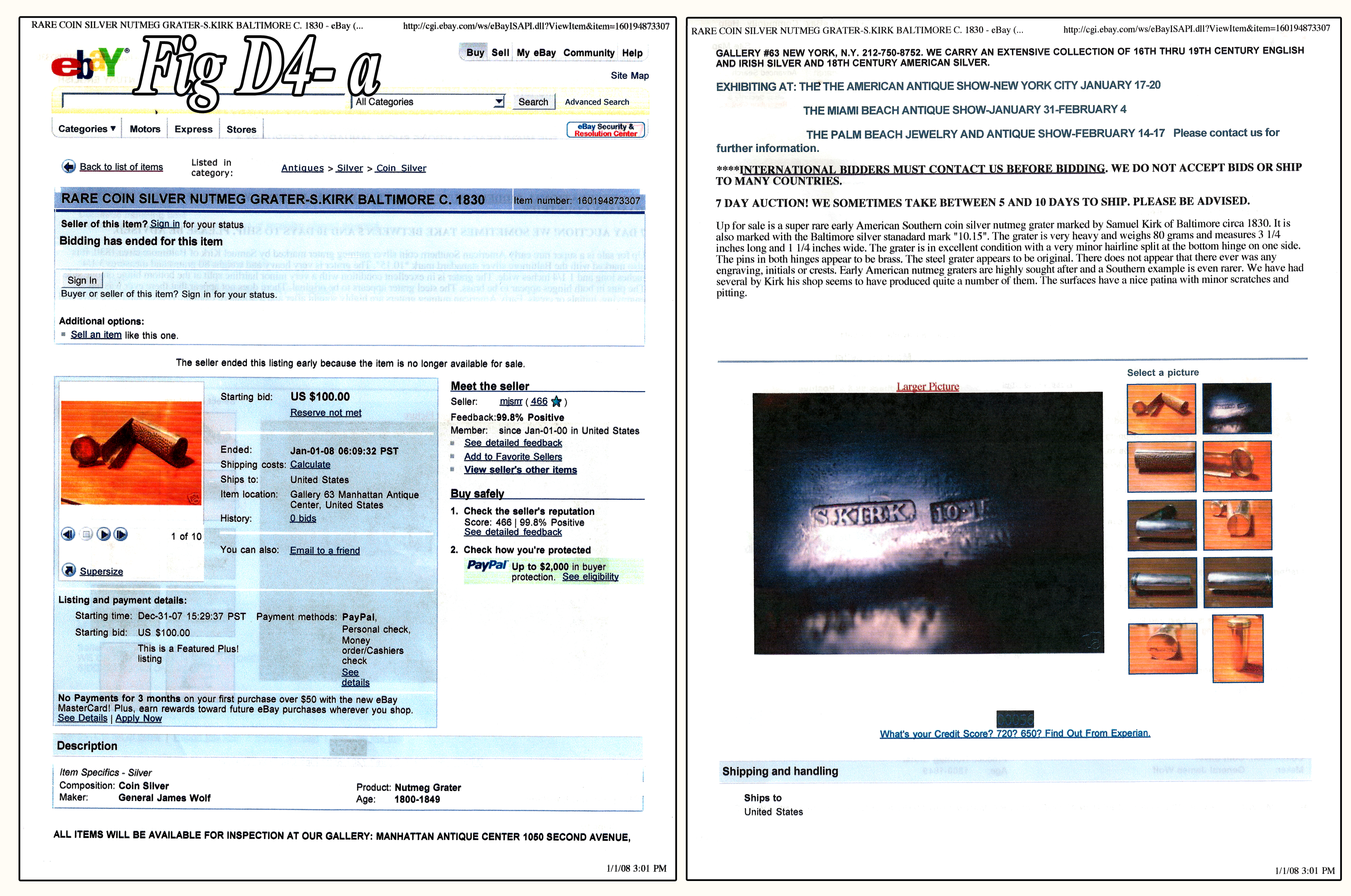 (Fig D1 & D2 [and D ~ series]) This cylindrical silver nutmeg grater with double hinged side and top cover was briefly listed for sale on E-Bay (1/1/08 ~ Item # 160194873307) by Robert Lloyd (Fig D4-a) who abruptly removed this item listing from E-Bay, quickly stopping the transaction prior to its final sale date. The Lloyd ad described this nutmeg grater: "Up for sale is a super rare early American Southern coin silver Nutmeg Grater marked by Samuel Kirk of Baltimore circa 1830. It is also marked with the Baltimore silver standard mark '10.15'. The grater is very heavy and weighs 80 grams and measures 3¼ inches long and 1¼ inches wide. The grater is in excellent condition with a very minor hairline split at the bottom hinge on one side. The pins in both hinges appear to be brass. The steel grater appears to be original. There does not appear that there ever was any engraving, initials or crests. Early American nutmeg graters are highly sought after and a Southern example is even rarer. We have had several by Kirk his shop seems to have produced quite a number of them. The surfaces have a nice patina with minor scratches and pitting." "ALL ITEMS WILL BE AVAILABLE FOR INSPECTION AT OUR GALLERY: MANHATTAN ANTIQUE CENTER, 1050 SECOND AVENUE, NEW YORK, N.Y. GALLERY #63. 212-750-8752". This same item reemerged for sale in March of 2008 by Ann Gillooly, of Robert Jackson | Ann Gillooly, Inc. 4897 Landisville Road, Doylestown, Pennsylvania, 18901; first by an e-mail containing photographs (Below: Fig D4-b), followed by mailed correspondence which described: "We have recently acquired an American Silver Nutmeg Grater by Samuel Kirk, Baltimore, MD., c 1835." and "Nutmeg Grater by SAMUEL KIRK, Baltimore, c. 1835, 3³⁄₈" long, Cylindrical Nutmeg grater with a hinged, pull out grater and a hinged lid. Marked inside 'S.KIRK.' '10.15'." with a written guarantee of authenticity provided by the seller.
(Fig D1 & D2 [and D ~ series]) This cylindrical silver nutmeg grater with double hinged side and top cover was briefly listed for sale on E-Bay (1/1/08 ~ Item # 160194873307) by Robert Lloyd (Fig D4-a) who abruptly removed this item listing from E-Bay, quickly stopping the transaction prior to its final sale date. The Lloyd ad described this nutmeg grater: "Up for sale is a super rare early American Southern coin silver Nutmeg Grater marked by Samuel Kirk of Baltimore circa 1830. It is also marked with the Baltimore silver standard mark '10.15'. The grater is very heavy and weighs 80 grams and measures 3¼ inches long and 1¼ inches wide. The grater is in excellent condition with a very minor hairline split at the bottom hinge on one side. The pins in both hinges appear to be brass. The steel grater appears to be original. There does not appear that there ever was any engraving, initials or crests. Early American nutmeg graters are highly sought after and a Southern example is even rarer. We have had several by Kirk his shop seems to have produced quite a number of them. The surfaces have a nice patina with minor scratches and pitting." "ALL ITEMS WILL BE AVAILABLE FOR INSPECTION AT OUR GALLERY: MANHATTAN ANTIQUE CENTER, 1050 SECOND AVENUE, NEW YORK, N.Y. GALLERY #63. 212-750-8752". This same item reemerged for sale in March of 2008 by Ann Gillooly, of Robert Jackson | Ann Gillooly, Inc. 4897 Landisville Road, Doylestown, Pennsylvania, 18901; first by an e-mail containing photographs (Below: Fig D4-b), followed by mailed correspondence which described: "We have recently acquired an American Silver Nutmeg Grater by Samuel Kirk, Baltimore, MD., c 1835." and "Nutmeg Grater by SAMUEL KIRK, Baltimore, c. 1835, 3³⁄₈" long, Cylindrical Nutmeg grater with a hinged, pull out grater and a hinged lid. Marked inside 'S.KIRK.' '10.15'." with a written guarantee of authenticity provided by the seller.
(A Fifth Example) An egg form silver nutmeg grater is known and bears the 'S.KIRK.' '10.15' maker's marks undifferentiated from the others shown above. This egg form nutmeg grater has not yet been made available for photographing and in-depth study to include in Profile # 6.
Review of the Literature:
The history of the Samuel Kirk And Son Company is well known. Trained during his youth, Samuel Kirk (1793~1872) was a silver apprentice for James Howell of Philadelphia. At age 21 in 1815, Samuel Kirk moved to Baltimore, where he entered into a brief partnership with John Smith, before taking full ownership of the business in 1820. Remaining in Baltimore for nearly 200 years, Samuel Kirk, and his firm are considered America's longest standing silver producers. In 1979, the corporation was purchased by Stieff, and renamed the Kirk-Stieff Company. The firm was purchased in 2007 by Lenox and later absorbed by Lifetime Brands.
Kirk is famous for their repoussé work, routinely termed today as "Maryland Silver" or the "Baltimore Style", which they produced throughout the nineteenth and into the first half of the twentieth century. Kirk also produced items in "up-dated nineteenth century reproductions of eighteenth century English and American models" including a variety of rare nutmeg graters. Kirk's nutmeg graters were produced between 1828 through 1914 and reflect both the tastes and technology of their design periods. Analyzing maker's mark, these too demonstrate the technical methods of their time. Curiously, Kirk nutmeg graters exist where two identical pieces were produced during different time interims, thus each bearing a differently Kirk maker's marks that reflect their dates of production [i.e.: "S. Kirk & Son" and "S. Kirk & Sons"; "S.K." and "S.KIRK" ].
Kirk silver is extremely well researched with the best documentation published directly by Samuel Kirk And Son Company. First published in 1914, their booklet The Story of The House of Kirk The Oldest Silversmiths in the United States, Founded 1815, details a concise account of the firms history, including highly detailed images of all the companies' maker's marks. Investigation Profile #6 examines the maker's marks "S .Kirk" "10•15" on four nutmeg graters, which differ from the "S. Kirk" "10.15" marks illustrated in Kirk's publication [see below, inside bright red enclosure / Source: The Story of The House of Kirk The Oldest Silversmiths in the United States, Founded 1815, eighth publication, Page 27, 1930]:
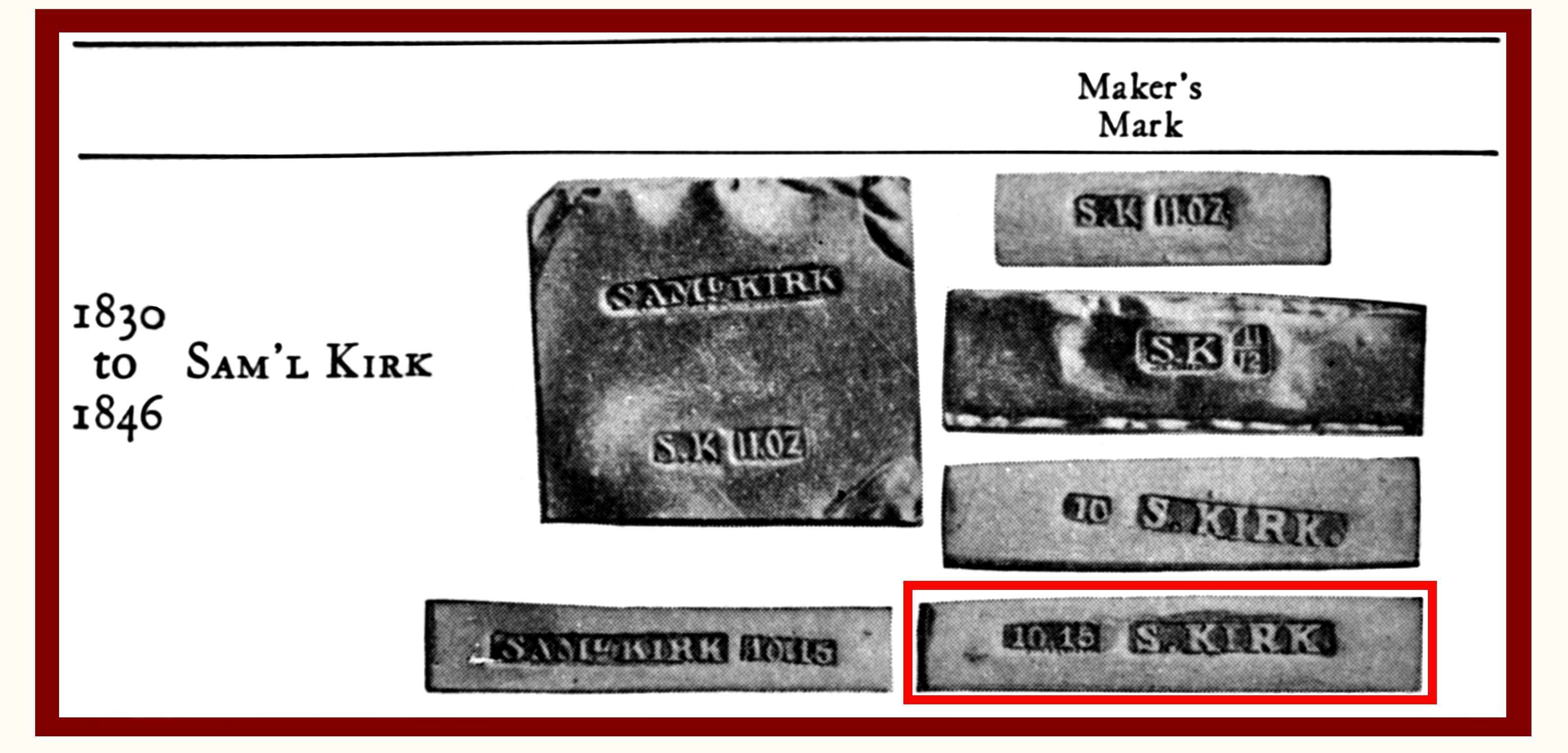 An Investigative Portfolio:
An Investigative Portfolio:
The following four investigative analysis procedures were used to assess the nutmeg graters bearing suspect "S .Kirk" maker's marks:
MAKER MARK ANALYISIS ~
Slight variations are expected when comparing the same maker's mark as applied to different silver items. The best account for this is detailed in Marks of American Silversmiths in the Ineson-Bissell Collection, Louise Conway Belden, University Press of Virginia, 1980; "Identification of Marks", Pages 21-23. The factors to account for subtle differences between marks struck using the same die include (but are not limited to): silver composition, hardness and quality; "differences in reflect wear, dirt or photographic technique"; the direction of the strike force applied by the silversmith, the amount of strike force; die slippage or lateral movement during the strike, die wear, and/or re-strike (or bounce) of the die. To determine usage of the same die, compare features of spacing, proportions, overall layout, shaping, styling, and most importantly, the identification of unique die flaws and shaping features of lettering and characters.
[NOTE: Photographing a maker's mark: a Canon MP-E-65 mm lens allows for a super-macro image (extreme close-up) which shows exceptional detail when viewing an original image on a high definition monitor/screen. The detail in images using the Canon MP-E-65 lens captures a high resolution photograph in magnificent quality. For example, this lens captures the image of one third of the tip of a pencil point to yield a high resolution image as large as 40 inches by 40 inches (100 cm X 100 cm). When viewing images throughout this website, keep in mind that by reducing resolution required for an ink-jet printer (at 300 DPI), the image quality is lessoned to only satisfactory image quality, and for a website (at 72 DPI) the image quality details are significantly lessoned to fair or marginal qualities. The actual Direct Visual Comparison between "Marks" was conducted using the highest resolution images available.]
[NOTE: To view most of the Images within this Web Page in enlarged detail. ~ First, "right-click" with curser directly on the image and then select "Open Image in New Tab".]
(I). Analyzing Marks ~ Direct Visual Comparison Of An Authenticated "Maker's Mark" Against A Spurious "Maker's Mark":
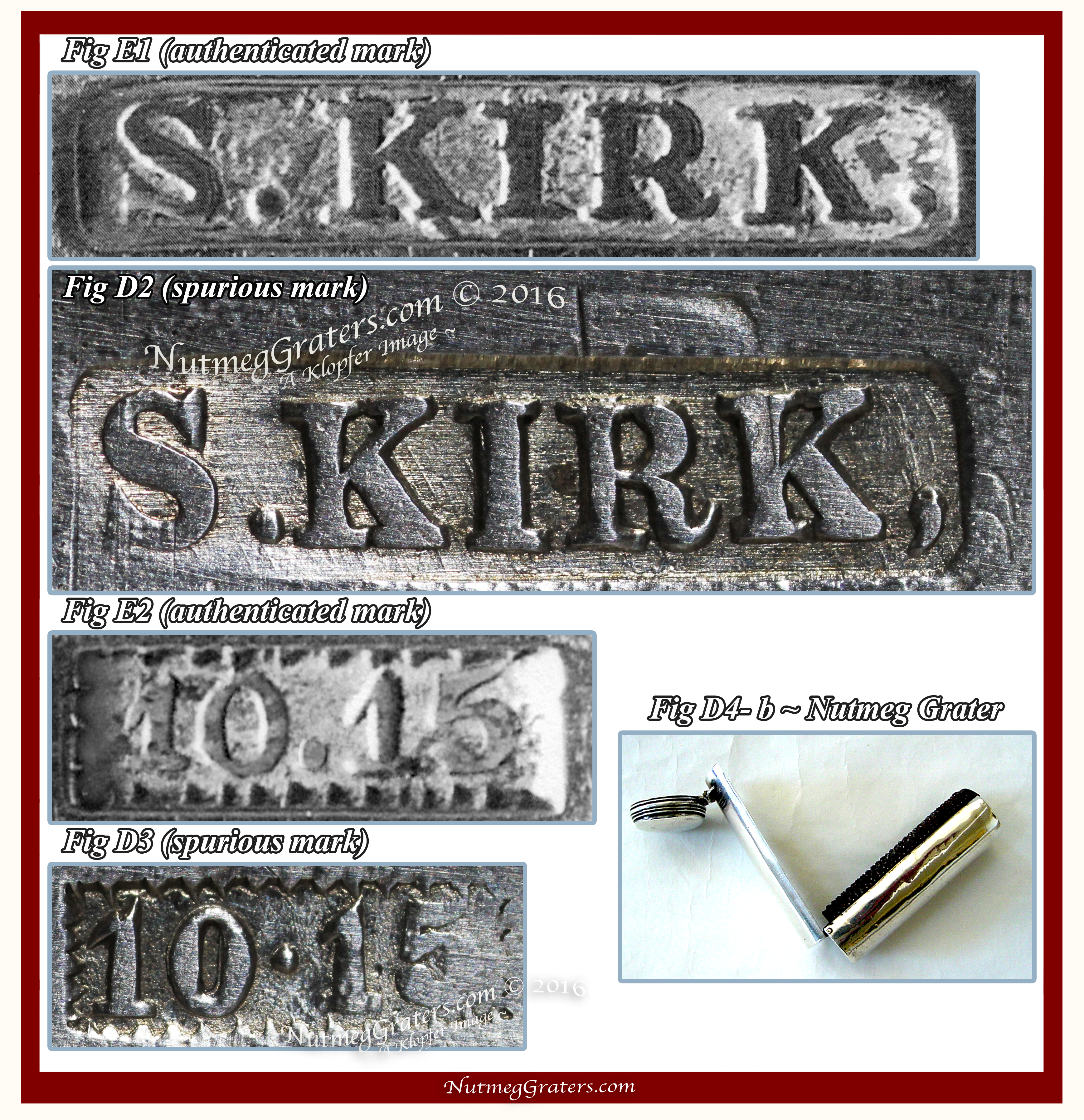 In this investigation, confirmed examples of the "S. Kirk" and "10.15", Circa 1830-1846 maker's and standard marks were acquired from multiple sources [including Winterthur's Decorative Arts Photographic Collection (DAPC), a collection containing abundant photographic images of American silver and their maker's marks; The Story of The House of Kirk The Oldest Silversmiths in the United States, Founded 1815; Samuel Kirk And Son: American Silver Craftsmen,
In this investigation, confirmed examples of the "S. Kirk" and "10.15", Circa 1830-1846 maker's and standard marks were acquired from multiple sources [including Winterthur's Decorative Arts Photographic Collection (DAPC), a collection containing abundant photographic images of American silver and their maker's marks; The Story of The House of Kirk The Oldest Silversmiths in the United States, Founded 1815; Samuel Kirk And Son: American Silver Craftsmen,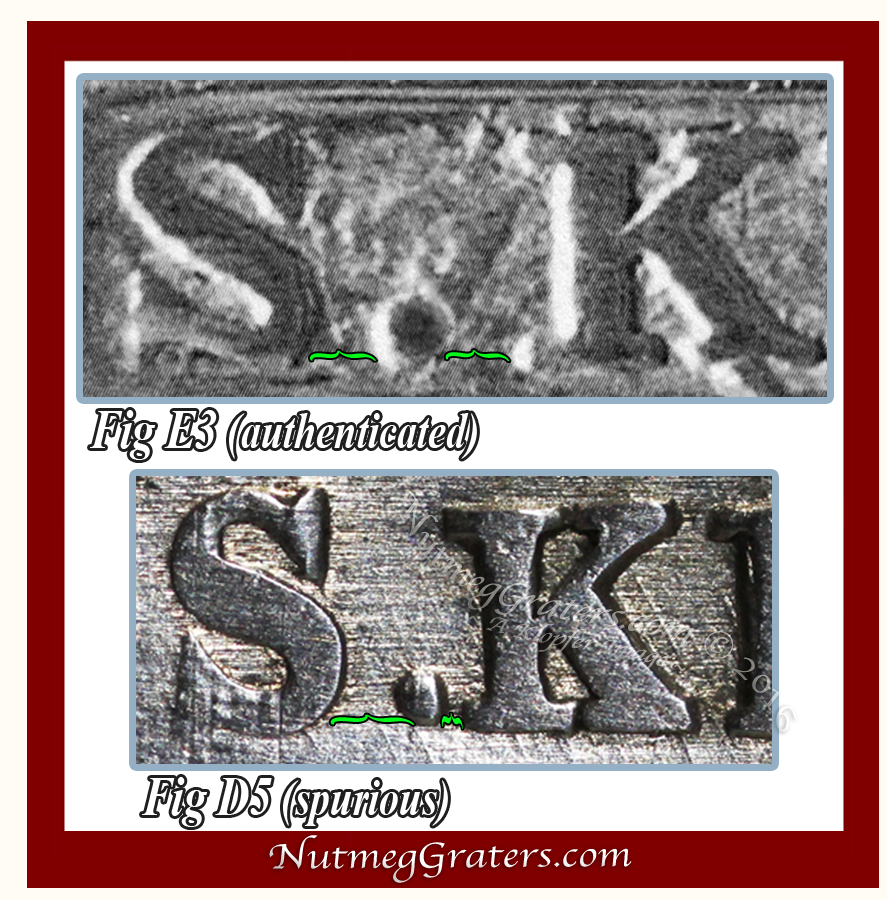 Samuel Kirk and Son Museum of Baltimore Pub., Maryland; Encyclopedia of American Silver Manufacturers, Dorothy Rainwater; Silver of the Americas, 1600-2000, American Silver in the Museum of Fine Arts, Boston, Jeannine Falino & Gerald Ward Eds.; and other on-line sources]. Provided with authenticated "S. KIRK" and "10.15" maker's mark images (Fig E1), a direct visual comparison was contrasted against the Canon MP-E-65 image of the maker's marks (Fig D2) from a nutmeg grater in question. [NOTE: Analysis Method IV permits the viewer to contrast the maker's marks on each nutmeg grater under investigation (Figs A1-2, Fig B1-2, Fig C1-2, Fig D1-2, Fig E3-D5, ), allowing each viewer to confirm for themselves that these marks are the product of the same spurious marking instrument (known as a: "name stamp" or "touchmark stamp").]
Samuel Kirk and Son Museum of Baltimore Pub., Maryland; Encyclopedia of American Silver Manufacturers, Dorothy Rainwater; Silver of the Americas, 1600-2000, American Silver in the Museum of Fine Arts, Boston, Jeannine Falino & Gerald Ward Eds.; and other on-line sources]. Provided with authenticated "S. KIRK" and "10.15" maker's mark images (Fig E1), a direct visual comparison was contrasted against the Canon MP-E-65 image of the maker's marks (Fig D2) from a nutmeg grater in question. [NOTE: Analysis Method IV permits the viewer to contrast the maker's marks on each nutmeg grater under investigation (Figs A1-2, Fig B1-2, Fig C1-2, Fig D1-2, Fig E3-D5, ), allowing each viewer to confirm for themselves that these marks are the product of the same spurious marking instrument (known as a: "name stamp" or "touchmark stamp").]
Using Direct Visual Comparison between high definition images, significant differences are apparent between the genuine "S.KIRK" maker's mark (Fig E1 & E2) and the counterfeit maker's mark (Fig D2 & D3). The maker's mark configurations are dissimilar, neither matching in letter proportioning nor spacing. Among many dissimilarities noted between the authenticated and the spurious marks, eight (8) significant differences are detailed here (the first 3 pertain to the maker's mark and the remaining 5 relate to the standard mark).
~ (Figs E3 &D5) compare the two maker's marks regarding the positioning of their 'period' symbols. Observe (Fig E3) [highlighted with green brackets] that the 'period' in the authenticated maker's mark is centered midpoint between the letter characters 'S.K'; whereas, the counterfeit mark (Fig D5) shows the 'period' positioned off-center, inaccurately close to the foot of the letter 'K'. [Further confirming this finding ~ examine the KIRK publication of marks for "1830 to 1846"(SEE ABOVE {Kirk's Page 27, 1930}) which also corroborates the centered positioning of the 'period' ].
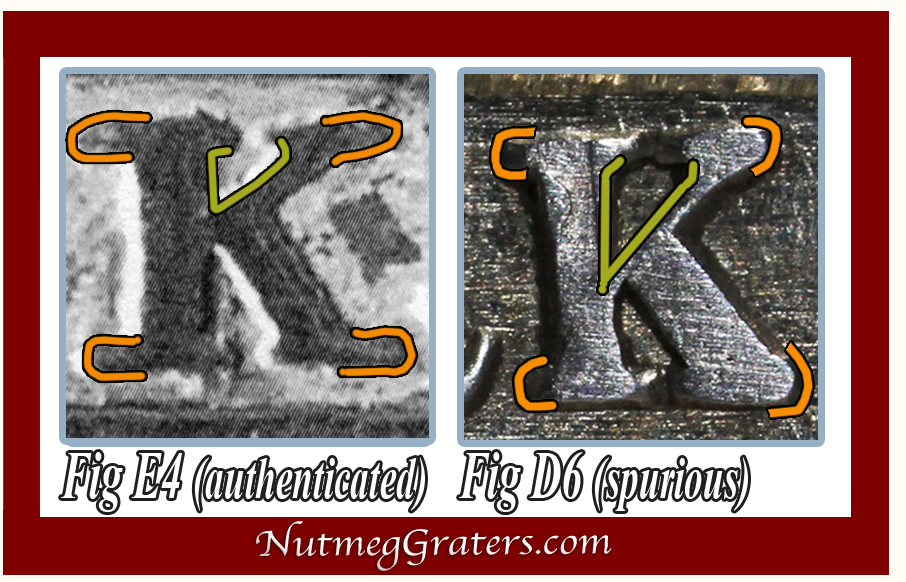
~ (Figs E4 & D6) feature two other matters in question. Firstly, compare the final-'K' characters from each "KIRK" maker's mark to see a significant differences in their letter shaping and styling. Notice [outlined in orange brackets] that all four serifs with the authenticated 'K' (Fig E4) are fully extended in letter formation as typically seen with letter marks on silver from this period. Observing the counterfeit final-'K' (Fig D6), all four serifs [traced in orange] are amateurish in formation: while the two on the left show short and stubby serifs, on the right side, there is no extension into a serif; instead, the tips are simple and rounded. Secondly, notice the shaping of final-'K'. The counterfeit example (Fig D6) displays a deep valley where the letter's "stem" intersects its "ascender" [highlighted using yellow lines]. Observing the authenticated example (Fig E4), this intersection is distinctly more shallow. As clearly demonstrated, these lettering proportions and formations do not coincide with each other when comparing these two final-'K' characters. 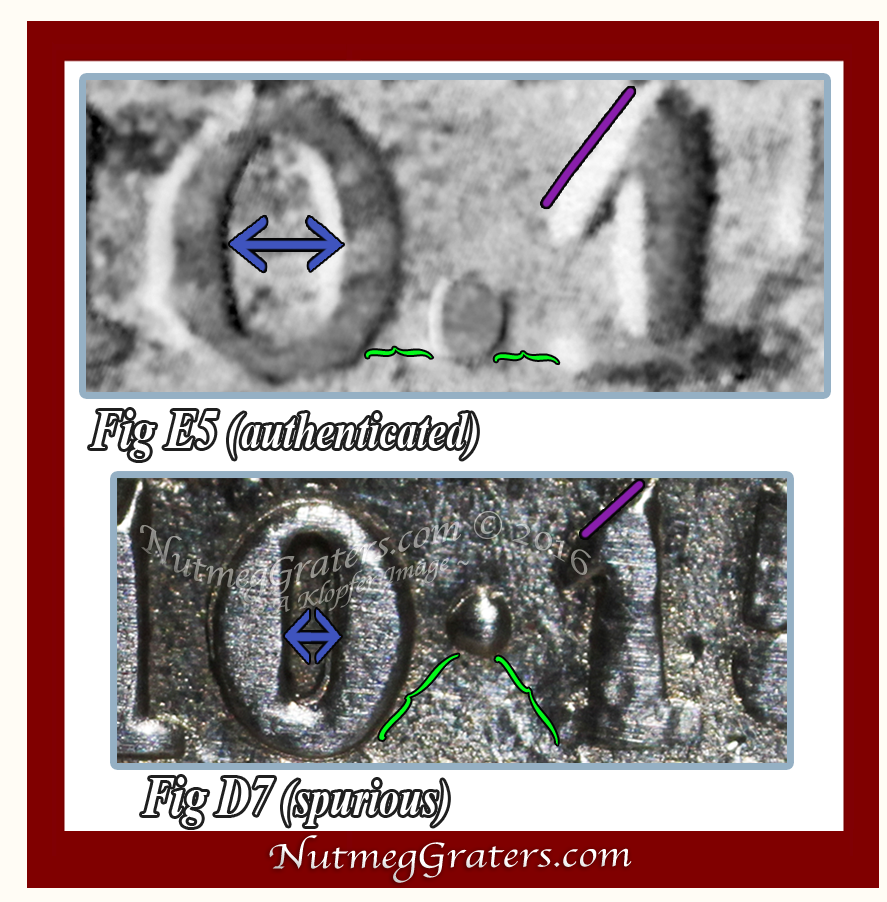
~ (Figs E5 & D7) highlight two problematic features found with the standard mark, the '10.15' mark applied on three of the nutmeg graters under investigation. First, there is a difference in positioning of the 'point' marks [note that the placement of 'point' marks (Figs E5 & D7) are emphasized between two green brackets]. The authenticated standard mark (Fig E5) displays a maker's mark with a 'period' centered at the bottom between the number characters: '10.15'; whereas the counterfeit mark (Fig D6) inaccurately uses a 'pellet' mark, centrally positioned: '10•15'. [Again, to further confirm these finding ~ the KIRK publication of marks for "1830 to 1846" (SEE ABOVE {Kirk's Page 27, 1930}) also authenticates a centered positioning using a 'period']. Another problem is seen regarding the number 'O'. The interior shape (or "counter") with the authenticated 'O' character (Fig E5) appears twice the width of that of the spurious '0' character (Fig D7) [the blue double-ended arrows display these differing widths].
~ (Figs E5, E6, D7& D8) provide the most revealing data to support counterfeiting. Delineated using straight purple lines, observe that within (Figs E5 & D7), the arm (or serif) descends from a top-point of each 'number 1' in a straight line . However, each 'number 1' in (Figs E6 & D8) shows an indented trough or notch at their top [the contour is silhouetted using a rounded purple line]. Clearly, the notch seen with the original 'number 1'(Fig E6) is a die flaw created during the
 making of the original stamping tool. And, the notch seen with the spurious 'number 1' (Fig D8) is the forger's attempt to recreate this flaw. These two notches (Figs E6 & D8) neither match in shaping nor proportion. Samuel Kirk certainly never purposefully recreated a second name stamp or touchmark stamp in an effort to imitate this flaw. Without question, this is a counterfeiter's attempt at recreating this die flaw for the purpose to fake authenticity.
making of the original stamping tool. And, the notch seen with the spurious 'number 1' (Fig D8) is the forger's attempt to recreate this flaw. These two notches (Figs E6 & D8) neither match in shaping nor proportion. Samuel Kirk certainly never purposefully recreated a second name stamp or touchmark stamp in an effort to imitate this flaw. Without question, this is a counterfeiter's attempt at recreating this die flaw for the purpose to fake authenticity.
~ (Figs E6 & D8) show two final problems associated with the standard marks in question. Notice that the 'mark outline' with both standard marks (Figs E6 & D8) are stylized within a 'barbed rectangle' [also note that we have represented each 'barb' within (Figs E6 & D8) using a single red bracket]. Examining the authenticated standard mark (Fig E6), there are three 'barbs' extending from the left side and three 'barbs' shown extended from the top.
Each 'barb' within the authenticated standard mark (Fig E6) is evenly spaced, identically sized, and points toward an imaged center-line within the rectangle. Observing the spurious standard mark (Fig D8), the 'barbs' are not evenly spaced ~ five 'barbs' extend from the left side and four 'barbs' are shown to extend from the top. While some 'barbs' point toward an imagined center-line within the rectangle, the two top left 'barbs' do not, instead pointing angularly toward the mark's mid-point. The 'barbs' seen with the spurious standard mark (Fig D8) are not uniformly shaped or proportioned. It is clearly seen that the 'barbs' (Fig D8) are poor quality imitations when compared with the authenticated standard mark (Fig E6). Most significant is that the spacing and number count of 'barbs' between these two standard marks do not match. Lastly, (Figs E6 & D8) reveal an additional irregularity in spacing. Note the expanses from the left side of the 'mark outline' to the number '10.15' [as highlighted using green brackets]. With the authenticated standard mark (Fig E6), there is a significantly broader expanse than seen with the spurious mark (Fig D8).
By comparison, the spacing does not match.
One final observation (Fig D9) pertains to the placement of the spurious maker's mark on the cylindrical silver nutmeg grater with double hinged side and top cover [D ~ series]. Depicted using an arrow, one observes evidence of a secondary mark. This draws the question: Was the current spurious maker's mark placed here in an attempt to cover or hide an earlier mark?
(II). Analyzing Marks ~ Direct Visual Comparison Of Distinctive Die Flaw Features Seen Commonly With All Four Spurious "Marker's Marks" [nutmeg graters (Figs A, B, C & D -series) under investigation]:
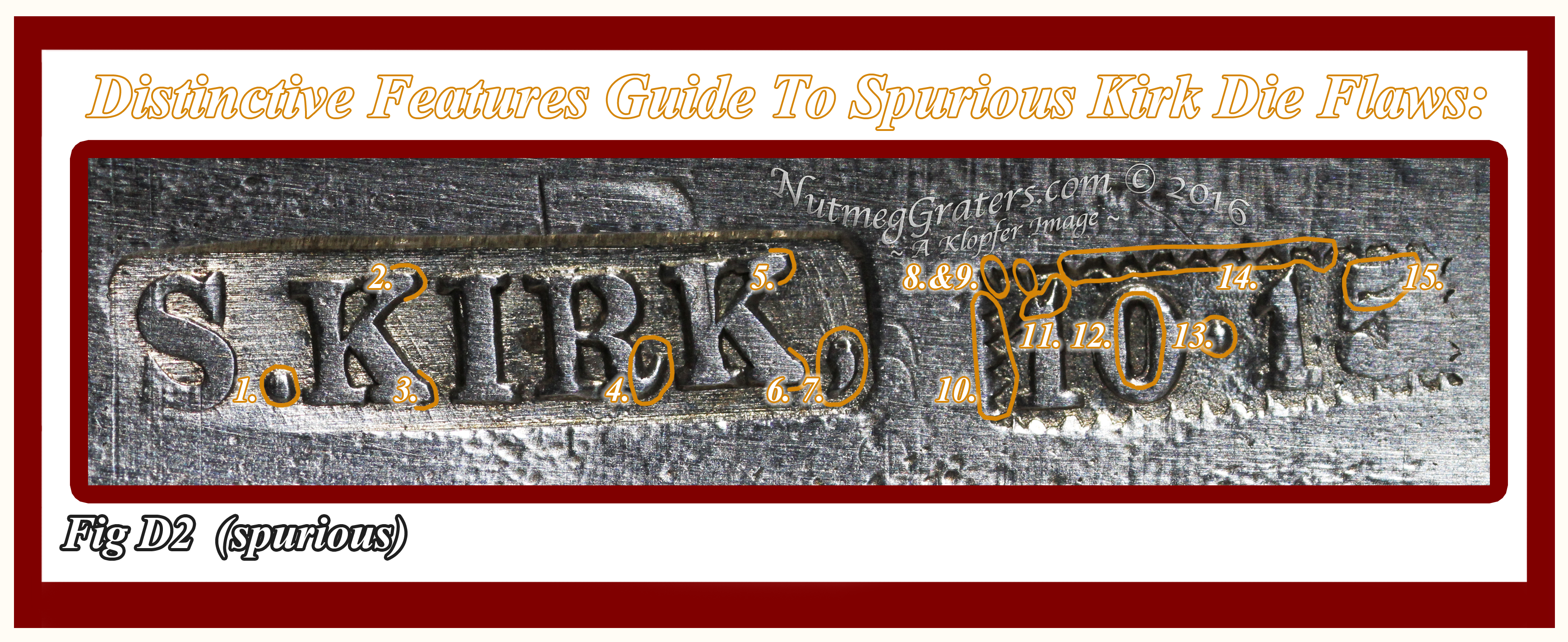 Notice that with the spurious maker's marks (SEE: Fig A2, Fig B2, Fig C2 & D2) and standard marks (SEE: Fig A2, Fig C2 & D2), these marks all possess identical distinctive die flaw features. Among these many flaws, a "Distinctive Feature Guide To Die Flaws" [located above (Fig D2 spurious)] was created to highlight [in orange] 13 examples:
Notice that with the spurious maker's marks (SEE: Fig A2, Fig B2, Fig C2 & D2) and standard marks (SEE: Fig A2, Fig C2 & D2), these marks all possess identical distinctive die flaw features. Among these many flaws, a "Distinctive Feature Guide To Die Flaws" [located above (Fig D2 spurious)] was created to highlight [in orange] 13 examples:
~ Distinctive Die Flaws Features #1 shows a problematic positioning of a 'period' located at the foot of the letter 'K' [rather than centered: 'S . K'].
~ Distinctive Die Flaws Features #2, #3, #5, #6: illustrates the absence of serifs which exist with authenticated marks.
~ Distinctive Die Flaws Features #4
encircles the terminal on letter 'R' being curvaceous and pointed in the spurious marks, the authentic letter
is shorter, intrinsic part to the foot.
~ Distinctive Die Flaws Features #7 appears as a comma within the spurious mark; but in the authentic mark appears as an ill-defined shaped die flaw.
~ Distinctive Die Flaws Features #8 & #9 are angularly misshaped 'barbs' with the spurious mark, but evenly shaped and spaced in the authentic mark.
~ Distinctive Die Flaws Features #10 & #14 emphasize a pattern of 'barbs' that significantly differs in spacing, number and proportion from
the authentic standard mark.
~ Distinctive Die Flaws Features #11illustrates an attempt to purposeful copy a known 'die flaw' seen in the genuine standard mark (unfortunately,
the reproduced 'die flaw' does not match the original in shape, size or proportion).
~ Distinctive Die Flaws Features #12 details the narrow width of number '0', not matching the wide width seen upon the genuine standard mark.
~ Distinctive Die Flaws Features #13 circles a 'pellet' mark, where the genuine standard mark has a 'period' mark.
~ Distinctive Die Flaws Features #14 encloses the upper row of 'barbs' which neither matches in number or distribution with the genuine
standard mark.
~ Distinctive Die Flaws Features #15 highlights the inaccurate shaping of the ascending 'arm' (top portion) of the number '5' that differs between the
spurious and genuine standard marks.
There are additional Distinctive Feature Die Flaws among the spurious marks and viewers are free to search for them. These flaws clearly indicate that the spurious maker's marks (Figs A2, B2, C2 and D2) were struck using the same counterfeiter's die.
(III). Analyzing Marks ~ Expert Testimony
It was a great pleasure conducting scholarly nutmeg grater research at the Kirk Silver Company in the early 1980's and at the Maryland Historical Society spanning the 1980's and 1990's. During this period, Kirk Silver Company opened their vault, allowing this author to photograph and study a nutmeg grater in their silver collection, and the Maryland Historical Society, who possesses a remarkable collection of KIRK silver (including examples of KIRK nutmeg graters), has remained welcoming to my study. The original name stamps or touchmark stamps used to create KIRK maker's marks and standard marks [marks shown above in the KIRK's publication of marks for "1830 to 1846" {Kirk's Page 27, 1930}] were safeguarded by the Kirk Silver Company, until they donated the entire set to the Maryland Historical Society. In 2010, given my suspicion of fraudulent "S.KIRK" maker's marks and standard marks on the silver nutmeg grates in question, I contacted the Maryland Historical Society with my concern. Upon inspection of the evidence, Mark Letzer, the current President & CEO, concluded, "I am not sure what to tell you regarding your pieces other than the mark does not match the ones in the MDHS collection". Based on this information, what followed was detailed study, resulting in the Investigation Profile outcomes now reported by NutmegGraters.Com.
(IV). Energy Dispersive X-ray Fluorescence Analysis (ED-XRF):
Dr. Jennifer L. Mass, Ph.D., of Scientific Analysis of Fine Art, LLC and Senior Scientist for Winterthur Museum, conducted x-ray fluorescent analysis on these nutmeg graters to measure the presents of its metal elements and the "fineness" of its silver content. "The first group contained three examples with the mark "S. Kirk". They include an S. Kirk tubular nutmeg grater (marked "10.15"), as well as an S. Kirk domed cylinder grater, and a Kirk cylindrical nutmeg grater with a double hinged cover. Noting known styles of nutmeg graters, the first Kirk grater is similar to French graters from the mid 1850s, the second to graters from Birmingham England, and the third to graters from England, the continent, or America" and "analysis was conducted to determine if the alloy of the pieces are period appropriate." Early "silver" [Ag] contained impurities such as "gold" [Au] and "lead" [Pb] which, after 1840 ~ 1860, were fully extracted during the refinement process of silver. Therefore, identifying these impurities indicates that an item's fabrication was prior to this time. Secondly, the degree of "fineness" (or, percentage of silver verses other metals) in antique silver varies among different countries and aides to support knowledge of its place of origin. "The 'Kal' x-ray line is more representative of the bulk composition of and object, whereas the Lal x-ray line provides more information about the surface composition of an object. Comparison of the data from the two lines can give an indication of surface treatments such as pickling and plating." Multiple test spots were sampled on each of three nutmeg graters as follow:
Grater (Fig A) - Tubular Nutmeg Grater marked"S .KIRK" "10•15". Dr. Mass stated: " This was originally sold as an unmarked George III grater, indicating that the S. KIRK mark must be spurious." Three areas were sampled:
[Test Spot #1] (Bottom) [Test Spot # 2] (Lid)
| ELEMENT | CONCENTRATION |
|---|---|
| Ag La1 | 92.9 wt. % |
| Cu Ka1 | 6.8 |
| Au La1 | 0.13 |
| Pb La1 | 0.25 |
| Ag Ka1 | 92.8 |
| ELEMENT | CONCENTRATION |
|---|---|
| Ag La1 | 94.9 wt. % |
| Cu Ka1 | 5.2 |
| Au La1 | 0.15 |
| Pb La1 | 0.23 |
| Ag Ka1 | 94.4 |
[Test Spot #3 ] (Side Edge)
| ELEMENT | CONCENTRATION |
|---|---|
| Ag La1 | 94.9 wt. % |
| Cu Ka1 | 5.0 |
| Au La1 | 0.14 |
| Pb La1 | 0.27 |
| Ag Ka1 | 94.7 |
Findings are based on copper [Cu], gold [Au] and lead [Pb] concentrations. Dr. Mass wrote: "Note that all measurements exceed the sterling standard, and that two are remarkably close to the Paris standard of 95 wt %, suggesting that there is in fact a French origin of the alloy. Present on each is the silver standard mark "10.15", indicating a silver standard of coin silver (.896) common to S. Kirk silver. This contradiction between the measured silver concentration and this marking is thus problematic. Also problematic is that the S. Kirk tubular nutmeg grater was originally sold as an 'unmarked George III' silver nutmeg grater, indicating that the S. Kirk mark must be spurious. The trace amounts of gold and lead are consistent with a pre-electrolytically refined alloy, predating the middle of the 19th century. "
Grater (Fig B) - A Domed Cylinder Grater With Friction Fit Lids marked "S .KIRK". Two areas were sampled:
[Test Spot #1] (Underside) [Test Spot # 2] (Side Edge)
| ELEMENT | CONCENTRATION |
|---|---|
| Ag La1 | 92.5 wt. % |
| Cu Ka1 | 7.2 |
| Au La1 | 0.13 |
| Pb La1 | 0.13 |
| Ag Ka1 | 92.6 |
| ELEMENT | CONCENTRATION |
|---|---|
| Ag La1 | 92.5 wt. % |
| Cu Ka1 | 7.2 |
| Au La1 | 0.13 |
| Pb La1 | 0.12 |
| Ag Ka1 | 92.6 |
Findings are based on copper [Cu], gold [Au] and lead [Pb] concentrations. Dr. Mass wrote: "Note that the alloy exceeds the English sterling standard, suggesting an English origin for this piece, suggesting that it may well have a Birmingham origin. The alloy was prepared prior to electrolytic refining which began c. 1840 in Europe."
Grater (Fig D) - A Cylindrical Nutmeg Grater With A Double Hinged Side and Top Cover marked "S .KIRK" "10•15". Two areas were sampled:
[Test Spot #1] (Underside) [Test Spot # 2] (Side Edge)
| ELEMENT | CONCENTRATION |
|---|---|
| Ag La1 | 96.5 wt. % |
| Cu Ka1 | 03.6 |
| Au La1 | 0.17 |
| Pb La1 | 0.21 |
| Ag Ka1 | 96.04 |
| ELEMENT | CONCENTRATION |
|---|---|
| Ag La1 | 95.7 wt. % |
| Cu Ka1 | 04.0 |
| Au La1 | 0.17 |
| Pb La1 | 0.45 |
| Ag Ka1 | 95.5 |
Findings are based on copper [Cu], gold [Au] and lead [Pb] concentrations. Dr. Mass wrote: "This piece exceeds the Paris standard of 95 wt. %, suggesting a continental origin for the silver."
ED-XRF Testing Summary and Conclusions(by Dr. Mass):
"Present on each piece is the silver standard mark '10.15', indicating a silver standard of coin silver (.896) common to S. Kirk silver." "The domed grater with the Kirk mark has an alloy composition suggesting an English origin (and not matching the 10:15 mark), while the other two Kirk marked graters exceed the Paris standard suggesting a continental origin for the silver. The Paris standard finding is in keeping with the French form of the monogrammed grater." "This contradiction between the measured silver concentration and this marking is thus problematic."
Investigation Outcome:
The four silver pocket nutmeg graters, in question, bear "spurious marks" and thus, are falsely attributed as the work of Samuel Kirk from Baltimore, Maryland, USA (working: 1815 to 1979 / marks investigated here compare to the similar, but authenticated "S.KIRK" "10.15" maker's mark used 1830 ~ 1846). A product study indicates that, although rather rare, Samuel Kirk produced silver nutmeg graters from Circa 1828 to Circa 1914. The counterfeited maker's mark and standard mark are the work of a very highly skilled artisan, being the most well crafted and finely executed quality forged set of marks that NutmegGraters.Com has encountered for study. Not withstanding these spurious marks, all of these silver pocket nutmeg graters under investigation are genuine eighteenth or early nineteenth century antiques, originally being unmarked.
The "fineness" quality with (Fig A1) the tubular nutmeg grater and (Fig D1) the cylindrical nutmeg grater with doubled hinged side & top cover are equivalent to that of the Paris standard of 95 wt. % and therefore deemed to originate from France; (Fig B1) the domed cylinder grater with friction fit lids exceeds the British standard reflecting English origin that may well be of Birmingham manufacture. ["Fineness" quality assessment was not conducted with the cylindrical silver nutmeg grater (Fig C1).]
Based on the Klopfer Image File, (Fig B1) the domed cylinder grater with friction fit lids is known prior to the British Statutes of 1790, after which all English silver nutmeg graters were required to be fully hallmarked. (Figs A1 & C1) the cylindrical silver nutmeg graters having a single top lid are typical of French nutmeg graters, and where originally unmarked in that French law requires no mandatory marks on silver. [ADDITIONAL NOTE: Advertisements published during the 1830's to the 1850's routinely labeled this style nutmeg grater as "French nutmeg graters"]. (Fig D1) the cylindrical nutmeg grater with doubled hinged side & top was a long produced style, known before 1790 through 1900 ~ this style was broadly produced throughout Europe and North America. The origins of all four antique nutmeg graters under investigation remain the work by unknown, and different silversmiths.
If you have a similarly marked item, we have interest to document and photograph pieces for further study.
[KLOPFER article © September 2016]